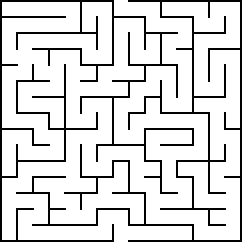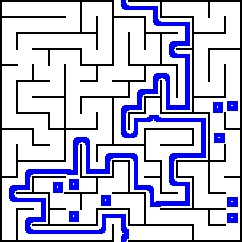Maze-Solver迷宫解密
这代码运行效果不是很好,感觉参考意义不是很大,github上有作者的原始讲解,大家可以去看看,C#和C++版本我暂时就不整理了,下面给大家提供下python原始代码的演示效果
https://ishankgulati.github.io/posts/Maze-Solver/
当前系列所有demo下载地址:
https://github.com/GaoRenBao/OpenCv4-Demo
不同编程语言对应的OpenCv版本以及开发环境信息如下:
语言 | OpenCv版本 | IDE |
C# | OpenCvSharp4.4.8.0.20230708 | Visual Studio 2022 |
C++ | OpenCv-4.5.5-vc14_vc15 | Visual Studio 2022 |
Python | OpenCv-Python (4.6.0.66) | PyCharm Community Edition 2022.1.3 |
C#版本运行效果及代码如下:
【略】
C++版本运行效果及代码如下:
【略】
Python版本运行效果及代码如下:
测试原图:
迷宫样图.zip

运行效果:

https://ishankgulati.github.io/posts/Maze-Solver/
import cv2
import numpy as np
# img = cv2.imread('SampleImages/1.png')
img = cv2.imread('../images/Solved-Maze.jpg')
# img = cv2.imread('SampleImages/3.jpg')#不行,得修改
# img = cv2.imread('SampleImages/huge_maze.jpg')#不行,得修改
cv2.imshow('maze', img)
# cv2.waitKey(0)
# Binary conversion
gray = cv2.cvtColor(img, cv2.COLOR_BGR2GRAY)
# 反转tholdolding将给我们一个二进制的图像与白色的墙壁和黑色的背景。
ret, thresh = cv2.threshold(gray, 127, 255, cv2.THRESH_BINARY_INV)
# cv2.imshow('THRESH_BINARY_INV',thresh)
# cv2.waitKey(0)
# Contours
contours, hierarchy = cv2.findContours(thresh, cv2.RETR_EXTERNAL, cv2.CHAIN_APPROX_NONE)
print('len(contours):', len(contours))
# dc=cv2.drawContours(thresh, contours, 0, (255, 255, 255), -1)
dc = cv2.drawContours(thresh, contours, 0, (255, 255, 255), 5) # 用不同颜色来标注
dc = cv2.drawContours(dc, contours, 1, (0, 0, 0), 5) # TODO 大迷宫的len(contours): 26
# cv2.imshow('drawContours',dc)
# cv2.waitKey(0)
ret, thresh = cv2.threshold(dc, 240, 255, cv2.THRESH_BINARY)
# ret, thresh = cv2.threshold(thresh, 240, 255, cv2.THRESH_BINARY)
# cv2.imshow('thresh2',thresh)
# cv2.waitKey(0)
# Dilate
'''
扩张
扩张是数学形态领域的两个基本操作者之一,另一个是侵蚀。
它通常应用于二进制图像,但有一些版本可用于灰度图像。
操作者对二进制图像的基本效果是逐渐扩大前景像素区域的边界(通常为白色像素)。
因此,前景像素的面积大小增加,而这些区域内的孔变小。
'''
ke = 10
# kernel = np.ones((19, 19), np.uint8)
kernel = np.ones((ke, ke), np.uint8)
dilation = cv2.dilate(thresh, kernel, iterations=1)
# cv2.imshow('dilation',dilation)
# cv2.waitKey(0)
# Erosion
# 侵蚀是第二个形态运算符。它也适用于二进制图像。
# 操作者对二进制图像的基本效果是消除前景像素区域的边界(通常为白色像素)。
# 因此,前景像素的面积缩小,并且这些区域内的孔变大。
erosion = cv2.erode(dilation, kernel, iterations=1)
# cv2.imshow('erosion',erosion)
# cv2.waitKey(0)
# 找到两个图像的差异
diff = cv2.absdiff(dilation, erosion)
# cv2.imshow('diff',diff)
# cv2.waitKey(0)
# splitting the channels of maze
b, g, r = cv2.split(img)
mask_inv = cv2.bitwise_not(diff)
# 为了在原始迷宫图像上显示解决方案,首先将原来的迷宫分割成r,g,b组件。
# 现在通过反转diff图像创建一个掩码。使用在最后一步中创建的掩码的原始迷宫的按位和r和g分量。
# 这一步将从迷宫解决方案的图像部分去除红色和绿色成分。最后一个是合并所有组件,我们将使用蓝色标记的解决方案。
# masking out the green and red colour from the solved path
r = cv2.bitwise_and(r, r, mask=mask_inv)
g = cv2.bitwise_and(g, g, mask=mask_inv)
res = cv2.merge((b, g, r))
cv2.imshow('Solved Maze', res)
# cv2.imwrite('Solved-Maze-1.png', res)
cv2.waitKey(0)
cv2.destroyAllWindows()





